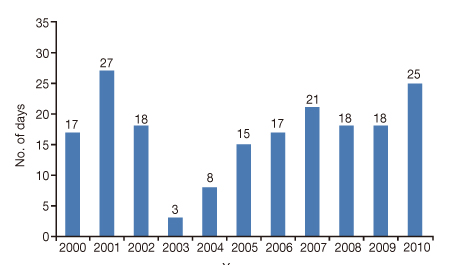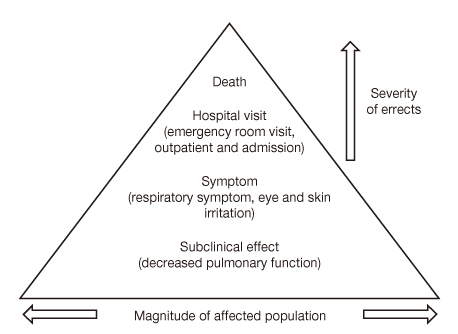J Korean Med Assoc.
2012 Mar;55(3):234-242. 10.5124/jkma.2012.55.3.234.
Toxicity and health effects of Asian dust: a literature review
- Affiliations
-
- 1Department of Preventive Medicine, Dankook University College of Medicine, Cheonan, Korea. hojang@dankook.ac.kr
- KMID: 2192713
- DOI: http://doi.org/10.5124/jkma.2012.55.3.234
Abstract
- Asian dust, called Hwangsa in Korean, is windblown dust originating from the desert areas of China and Mongolia. Public concern on the possible adverse health effects of Asian dust has increased recently. Some experimental studies have reported that Asian dust aggravates the allergic response and induces cytotoxicity by promoting the release of reactive oxygen species. Asian dust may potentiate common cold symptoms associated with rhinovirus infection by enhancing inflammatory cytokines and increasing viral replication. In many epidemiologic studies conducted not only in Korea but also in Taiwan and Japan, Asian dust exposure has been reported to be associated with an increase in mortality and hospital visits and admission due to cardiovascular and respiratory disease as well as increased respiratory symptoms and decreased pulmonary function. The frequency and scale of Asian dust events are expected to increase due to environmental change such as desertification in northern China and climate change. We need an Asian dust preparedness strategy including monitoring of dust-related health outcomes as well as an enhanced Asian dust forecasting system to protect people from the effects of Asian dust events.
Keyword
MeSH Terms
Figure
Cited by 1 articles
-
Guideline for the prevention and management of particulate matter/Asian dust particle-induced adverse health effect on the patients with pulmonary diseases
Sun Young Kyung, Young Sam Kim, Woo Jin Kim, Moo Suk Park, Jin Woo Song, Hokee Yum, Hyoung Kyu Yoon, Chin Kook Rhee, Sung Hwan Jeong
J Korean Med Assoc. 2015;58(11):1060-1069. doi: 10.5124/jkma.2015.58.11.1060.
Reference
-
1. Chun Y. From historical dustfall to early warning of Asian dust events in Korea. J Korean Med Assoc. 2004. 47:446–452.2. Kwon HJ, Cho SH. The health effects of Asian dust event. J Korean Med Assoc. 2004. 47:465–470.3. National Institute of Environmental Research. Annual report of air quality in Korea 2010. 2011. Gwacheon: Ministry of Environment;444.
Article4. Qian W, Zhu Y. Climate change in China from 1880 to 1998 and its impact on the environmental condition. Clim Change. 2001. 50:419–444.
Article5. Kim HS, Chung YS, Lee SG. Characteristics of aerosol types during large-scale transport of air pollution over the Yellow Sea region and at Cheongwon, Korea, in 2008. Environ Monit Assess. 2012. 184:1973–1984. 2011 May 14 [Epub]. DOI: 10.1007/s10661-011-2092-9.
Article6. Kim MY. Physical and chemical characteristics of Asian dust. J Korean Med Assoc. 2004. 47:453–464.
Article7. Lee S, Choi B, Yi SM, Ko G. Characterization of microbial community during Asian dust events in Korea. Sci Total Environ. 2009. 407:5308–5314.
Article8. Zanobetti A, Schwartz J, Gold D. Are there sensitive subgroups for the effects of airborne particles? Environ Health Perspect. 2000. 108:841–845.
Article9. Donaldson K, Stone V, Borm PJ, Jimenez LA, Gilmour PS, Schins RP, Knaapen AM, Rahman I, Faux SP, Brown DM, MacNee W. Oxidative stress and calcium signaling in the adverse effects of environmental particles (PM10). Free Radic Biol Med. 2003. 34:1369–1382.10. Committee on Research Priorities for Airborne Particulate Matter, National Research Council (US). Research priorities for airborne particulate matter. IV. Continuing research progress. 2004. Washington, DC: National Academies Press;372.11. Kim YH, Kim KS, Kwak NJ, Lee KH, Kweon SA, Lim Y. Cytotoxicity of yellow sand in lung epithelial cells. J Biosci. 2003. 28:77–81.12. Lei YC, Chan CC, Wang PY, Lee CT, Cheng TJ. Effects of Asian dust event particles on inflammation markers in peripheral blood and bronchoalveolar lavage in pulmonary hypertensive rats. Environ Res. 2004. 95:71–76.13. Hiyoshi K, Ichinose T, Sadakane K, Takano H, Nishikawa M, Mori I, Yanagisawa R, Yoshida S, Kumagai Y, Tomura S, Shibamoto T. Asian sand dust enhances ovalbumin-induced eosinophil recruitment in the alveoli and airway of mice. Environ Res. 2005. 99:361–368.
Article14. Naota M, Mukaiyama T, Shimada A, Yoshida A, Okajima M, Morita T, Inoue K, Takano H. Pathological study of acute pulmonary toxicity induced by intratracheally instilled Asian sand dust (kosa). Toxicol Pathol. 2010. 38:1099–1110.
Article15. He M, Ichinose T, Yoshida S, Nishikawa M, Mori I, Yanagisawa R, Takano H, Inoue K, Sun G, Shibamoto T. Airborne Asian sand dust enhances murine lung eosinophilia. Inhal Toxicol. 2010. 22:1012–1025.
Article16. He M, Ichinose T, Yoshida S, Yamamoto S, Inoue K, Takano H, Yanagisawa R, Nishikawa M, Mori I, Sun G, Shibamoto T. Asian sand dust enhances murine lung inflammation caused by Klebsiella pneumoniae. Toxicol Appl Pharmacol. 2012. 258:237–247.
Article17. Yeo NK, Hwang YJ, Kim ST, Kwon HJ, Jang YJ. Asian sand dust enhances rhinovirus-induced cytokine secretion and viral replication in human nasal epithelial cells. Inhal Toxicol. 2010. 22:1038–1045.
Article18. Kwon HJ, Cho SH, Chun Y, Lagarde F, Pershagen G. Effects of the Asian dust events on daily mortality in Seoul, Korea. Environ Res. 2002. 90:1–5.
Article19. Lee BE, Wang SS, Park HS, Ha EH, Kwon HJ, Lee JT, Cho YS, Park YS, Leem JH, Hong YC, Cho SH, Pang MG. The effects of Asian dust events on perceived symptoms and behavior of elementary school students. J Korean Soc Sch Health. 2003. 16:1–8.
Article20. Park JW, Lim YH, Kyung SY, An CH, Lee SP, Jeong SH, Ju YS. Effects of ambient particulate matter on peak expiratory flow rates and respiratory symptoms of asthmatics during Asian dust periods in Korea. Respirology. 2005. 10:470–476.
Article21. Yoo Y, Choung JT, Yu J, Kim DK, Koh YY. Acute effects of Asian dust events on respiratory symptoms and peak expiratory flow in children with mild asthma. J Korean Med Sci. 2008. 23:66–71.
Article22. Hong YC, Pan XC, Kim SY, Park K, Park EJ, Jin X, Yi SM, Kim YH, Park CH, Song S, Kim H. Asian dust storm and pulmonary function of school children in Seoul. Sci Total Environ. 2010. 408:754–759.
Article23. Kim JY, Baek KJ, Lee KR, Lee YJ, Hong DY. Effect of the Asian dust events on respiratory disease during the spring. J Korean Soc Emerg Med. 2007. 18:326–332.
Article24. Hwang SS, Cho SH, Kwon HJ. Effects of the severe Asian dust events on daily mortality during the spring of 2002, in Seoul, Korea. J Prev Med Public Health. 2005. 38:197–202.
Article25. Lee JT, Son JY, Cho YS. A comparison of mortality related to urban air particles between periods with Asian dust days and without Asian dust days in Seoul, Korea, 2000-2004. Environ Res. 2007. 105:409–413.
Article26. Chen YS, Sheen PC, Chen ER, Liu YK, Wu TN, Yang CY. Effects of Asian dust storm events on daily mortality in Taipei, Taiwan. Environ Res. 2004. 95:151–155.
Article27. Chiu HF, Tiao MM, Ho SC, Kuo HW, Wu TN, Yang CY. Effects of Asian dust storm events on hospital admissions for chronic obstructive pulmonary disease in Taipei, Taiwan. Inhal Toxicol. 2008. 20:777–781.
Article28. Cheng MF, Ho SC, Chiu HF, Wu TN, Chen PS, Yang CY. Consequences of exposure to Asian dust storm events on daily pneumonia hospital admissions in Taipei, Taiwan. J Toxicol Environ Health A. 2008. 71:1295–1299.
Article29. Yang CY, Cheng MH, Chen CC. Effects of Asian dust storm events on hospital admissions for congestive heart failure in Taipei, Taiwan. J Toxicol Environ Health A. 2009. 72:324–328.
Article30. Yang CY, Chen YS, Chiu HF, Goggins WB. Effects of Asian dust storm events on daily stroke admissions in Taipei, Taiwan. Environ Res. 2005. 99:79–84.
Article31. Yang CY, Tsai SS, Chang CC, Ho SC. Effects of Asian dust storm events on daily admissions for asthma in Taipei, Taiwan. Inhal Toxicol. 2005. 17:817–821.
Article32. Chang CC, Lee IM, Tsai SS, Yang CY. Correlation of Asian dust storm events with daily clinic visits for allergic rhinitis in Taipei, Taiwan. J Toxicol Environ Health A. 2006. 69:229–235.
Article33. Yang CY. Effects of Asian dust storm events on daily clinical visits for conjunctivitis in Taipei, Taiwan. J Toxicol Environ Health A. 2006. 69:1673–1680.
Article34. Otani S, Onishi K, Mu H, Kurozawa Y. The effect of Asian dust events on the daily symptoms in Yonago, Japan: a pilot study on healthy subjects. Arch Environ Occup Health. 2011. 66:43–46.
Article35. Watanabe M, Yamasaki A, Burioka N, Kurai J, Yoneda K, Yoshida A, Igishi T, Fukuoka Y, Nakamoto M, Takeuchi H, Suyama H, Tatsukawa T, Chikumi H, Matsumoto S, Sako T, Hasegawa Y, Okazaki R, Horasaki K, Shimizu E. Correlation between Asian dust storms and worsening asthma in western Japan. Allergol Int. 2011. 60:267–275.
Article36. Ueda K, Nitta H, Odajima H. The effects of weather, air pollutants, and Asian dust on hospitalization for asthma in Fukuoka. Environ Health Prev Med. 2010. 15:350–357.
Article
- Full Text Links
- Actions
-
Cited
- CITED
-
- Close
- Share
- Similar articles
-
- Perceptions of the Asian Dust: Analysis of the Newspaper Articles about the Asian Dust
- The Health Effects of Asian Dust Event
- Road dust and its effect on human health: a literature review
- Health Effects of Particulate Matter
- Public Perceptions of the Risk of Asian Dust Storms in Seoul and its Metropolitan Area



